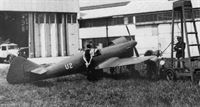
Miles M.12 Mohawk, M.13 Hobby, M.15 и M.18
<...>
Одноместный самолет M.13 Hobby строился для участия в гонках на Королевский кубок 1937 года, на машине стоял мотор de Havilland Gipsy Major II мощностью 140 л. с. Из-за сложностей с убираемым шасси самолет не достроили, но продали британским ВВС для продувок в натурной аэродинамической трубе.
<...>
Описание:
- Miles M.12 Mohawk, M.13 Hobby, M.15 и M.18
- Flight, September 1937
A PROPORTIONAL DEPARTURE
Фотографии
-
Aeroplane Monthly 1978-02 / D.Brown - Miles M.13 Hobby /British pre-war ultralights/
Регистрационный номер: G-AFAW [10], L9706 [10] A rare photograph of the Hobby in the air, taken only days before the 1937 King's Cup Race.
With its feet tucked up, and with a final coat of dope, the Miles Hobby will look far prettier than it does in this, its experimental state. -
Aeroplane Monthly 1978-02 / D.Brown - Miles M.13 Hobby /British pre-war ultralights/
Регистрационный номер: G-AFAW [10], L9706 [10] WOODWORK AS A HOBBY: Mr. F. G. Miles' own pet entry for the King's Cup race. Christened the Hobby, it is powered with one of the new Series II Gipsy Majors driving a "1,000" size D.H. v.p. airscrew. Unorthodox features of this fascinating little wooden racer are the wide track and the short span, which is actually less than the length.
-
Flight 1938-06 / Flight
Регистрационный номер: G-AFAW [10], L9706 [10] FOR INDOOR FLYING: The little Miles Hobby undergoing a fuel flow test before going to Farnborough, where it is to be used for research in the full-scale wind tunnel. The machine is small enough to be tested complete.
-
Aeroplane Monthly 1978-02 / D.Brown - Miles M.13 Hobby /British pre-war ultralights/
Регистрационный номер: G-AFAW [10], L9706 [10] MAJOR-POWERED MINOR. The diminutive Hobby single-seater sports monoplane which will be the mount of its designer - Mr. F. G. Miles - in the King's Cup Race. It has one of the new Gipsy Major II engines.
The nearly complete Hobby at Woodley, minus its cockpit canopy and wheel covers. Note the wide track undercarriage. -
Air-Britain Archive 1980-04
Регистрационный номер: G-AFAW [10], L9706 [10] The Miles M.13 Hobby G-AFAW was the smallest aircraft built by the company and their first lightplane with retractable undercarriage. Problems with this undercarriage prevented it from entering the 1937 King's Cup and this photograph shows the Hobby before it was fully painted and registered U2 for its first flight on 4.9.37 running up at Woodley with F.G.Miles at the controls.
-
Aeroplane Monthly 1978-02 / D.Brown - Miles M.13 Hobby /British pre-war ultralights/
Регистрационный номер: G-AFAW [10], L9706 [10] The Hobby, bearing the Class B markings U2, at Woodley in June 1938 during fuel flow tests.
-
Aeroplane Monthly 1978-02 / D.Brown - Miles M.13 Hobby /British pre-war ultralights/
Регистрационный номер: L9706 [10], G-AFAW [10] Seen after removal from the RAE’s wind tunnel, the Hobby now bears roundels and the serial L9706. It was struck off charge on July 24, 1939, and never flew again.
-
Aeroplane Monthly 1978-02 / D.Brown - Miles M.13 Hobby /British pre-war ultralights/
Регистрационный номер: G-AFAW [10], L9706 [10] -
Aeroplane Monthly 1978-02 / D.Brown - Miles M.13 Hobby /British pre-war ultralights/
Регистрационный номер: G-AFAW [10], L9706 [10] The Hobby nearing completion at Woodley in September 1937. It was the first Miles aircraft to have a retractable undercarriage.
-
Aeroplane Monthly 1978-02 / D.Brown - Miles M.13 Hobby /British pre-war ultralights/
Регистрационный номер: G-AFAW [10], L9706 [10] The Hobby was sold to the Royal Aircraft Establishment in May 1938, and is seen here in Farnborough's 24 ft wind tunnel in December of that year.
-
Flight 1937-09 / Flight
This G.A. drawing shows the unusual proportions of the Miles Hobby and the relatively wide track of the undercarriage.
- Фотографии











